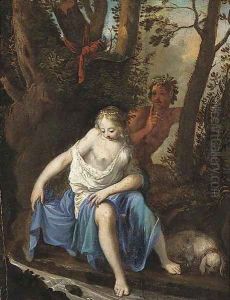Nicolas Van Schoor Paintings
Nicolas Van Schoor was a Flemish Baroque painter known for his contributions to the art world during the 17th century. Born in 1619 in Antwerp, Belgium, Van Schoor was part of a region that was a significant center for the arts during the Baroque period. This era in European history is characterized by its dramatic, intricate, and expressive style, a response to the Protestant Reformation and the Counter-Reformation. Van Schoor’s work, although not as widely recognized as some of his contemporaries, remains an important part of the Flemish contribution to the Baroque movement.
Nicolas Van Schoor's early life was deeply rooted in the rich artistic culture of Antwerp. He was likely influenced by the works of Peter Paul Rubens, Anthony van Dyck, and Jacob Jordaens, who were the leading figures in Flemish Baroque art. However, detailed records of his training and early career are scarce, which is common for many artists of his time. It is believed that he was part of the Guild of St. Luke, a city guild for painters and other artists, which played a crucial role in the artistic life of the region.
Throughout his career, Van Schoor specialized in religious subjects, often incorporating the dynamic figures and dramatic lighting typical of the Baroque style. His works were known for their emotional depth and attention to detail, characteristics that made them resonate with the religious and spiritual fervor of the period. Despite his evident skill and the quality of his paintings, Nicolas Van Schoor did not achieve the same level of fame as his contemporaries. This could be attributed to the vast number of talented artists working in Flanders at the time, which made the artistic landscape highly competitive.
Nicolas Van Schoor's contributions to art were not limited to his paintings. He also played a role in the cultural and possibly the educational aspects of the Antwerp artistic community, though specifics about these activities are hard to come by. Like many artists of his era, his works would have been commissioned by the church, the nobility, and wealthy patrons, which was the primary means for an artist to earn a living during this period.
Van Schoor died in 1668 in Antwerp, leaving behind a legacy that, while not as celebrated as some of his peers, contributes to the understanding and appreciation of Flemish Baroque art. His paintings, preserved in museums and private collections, continue to be studied and admired for their beauty and historical value. Nicolas Van Schoor’s life and work exemplify the vibrancy and depth of the Baroque period in Flanders, highlighting the rich tapestry of artistic achievement in 17th century Europe.
